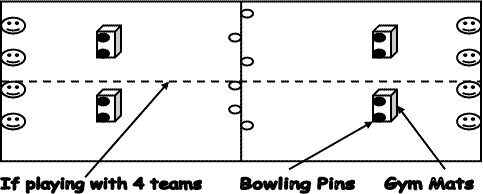PE Equipment Can Be Simple
written by Derek
Severson, Midway Elementary, Des Moines, Washington
 Physical
inactivity has contributed to increased cases of obesity and
other life threatening diseases in children and adolescents.
The opportunity to exercise has become increasingly difficult
for our youth because of limited access to equipment while
at home and at school. Research has shown that children may
choose not to be physically active, even if given the opportunity,
because they are not provided with some type of game equipment. Physical
inactivity has contributed to increased cases of obesity and
other life threatening diseases in children and adolescents.
The opportunity to exercise has become increasingly difficult
for our youth because of limited access to equipment while
at home and at school. Research has shown that children may
choose not to be physically active, even if given the opportunity,
because they are not provided with some type of game equipment.
I have taught physical education for
seven years, and in each of these years I have had limited
funding for equipment. Many physical education teachers deal
with this problem each year. In a study conducted by the Roslow Research Group in 2009,
researchers attempted to determine
the average annual budget for school physical education programs
in 1102 schools. The median budget found from this data
showed an annual average of $460 in elementary schools,
$900 in middle school, and $1370 in high schools. As an elementary
physical education teacher, I have often found my yearly budget
below this median for elementary schools.
Many schools and families in my surrounding
community often lack the money to purchase adequate game equipment
for school and home use. Seeing this issue, I thought of a
way to provide game equipment to my students at little to
no cost. The limited funding I had been receiving each year
eventually led me to the idea of creating homemade physical
education equipment for my school's physical education program.
In 2011, I took this idea of mine
and created a physical education equipment-making manual to
show creative and inexpensive ways to build equipment children
can use to be physically active at school and home. More than
a year later, I completed a 200 page manual that provides
instruction on how to build 15 different pieces of physical
education equipment, and nearly 150 activities that incorporate
this homemade equipment. Equipment and activities in this
guide were formed using personal ideas, past experiences,
and collaborations with other physical education teachers.
The equipment building section in
this manual includes: recommended grade level for use, supplies
needed for building, detailed instructions for building, and
step-by-step pictures that coincide with the instructions
for building.
The activity section in this manual
includes: recommended grade levels for play, skill and movement
concepts, equipment needed for teaching and playing, a description
of rules and directions, a diagram, safety considerations,
and EALR and NASPE standards. An example from this section
can be seen at the end of this article.
Saving money is just one of many benefits
of creating your own physical education equipment. One piece
of equipment included in this manual was a homemade
hula hoop. I found the average price to purchase hula hoops
from a vendor or equipment catalog to be about 10 dollars.
By purchasing the necessary materials at a local hardware
store, I was able to build hula hoops that were stronger and
more durable than those from a catalog or vendor. I was able
to customize
the size of these hula hoops and add unique features to each
one by placing small, noise-making beads inside and placing
colorful
tape around the outside. The average cost to build each
of these hula hoops was only 4 dollars.
I have seen many benefits since creating
this equipment-making manual. Since its completion, I have
been able to present this manual and its equipment to the
families of our students at school events. I have presented
this equipment-making manual to all other elementary physical
education teachers within my school district. My school district
has since agreed to print and bind copies for each of the
14 elementary school's physical education programs. Lastly,
I have been able to maximize participation and increase physical
activity levels in my students because they no longer have
to wait their turn to use a piece of equipment.
Physical activity equipment can be
the motivation your students need to increase their participation
in your classroom. The next time you are presented with a
limited budget for your physical education program, I highly
suggest going the alternative route, stretching your dollar,
and creating your own activity equipment.
If this article sparked your interest
and you would like to know more about how you can go about
creating a manual or equipment of your own, feel free to contact
me.
Derek Severson
Midway Elementary, Highline School District
Des Moines, Washington
derek.severson@highlineschools.org
Bowling Pin Knock-off
(Grades 1-12)
Skills
and Concepts
• Teamwork
•
Defense (blocking throw attempts)
• Throwing
• Accuracy (throwing at targets)
|
Equipment Needed
• Gym mats or elevated surface
• 12-20
bowling pins
• Soft throwing balls
|
Description
- The objective of this activity is to knock the bowling
off of an elevated surface (stacked gym mats work best;
can place them on scooters so the targets can be mobile).
- Divide players into two large
groups.
- Divide the playing area into two
zones with multiple gym mats (with about 3-4 bowling pins
on top) on each side. Do not place the targets so far back
that the weaker players have a difficult time throwing as
far as the bench.
- Mark off or establish a line around
the bench that no defensive player may go into.
- Players may not cross into the
other team's area (half-court line divides the two).
- Players may only hold one ball
at a time.
- If a pin is knocked down, even
accidentally, it stays down.
- Variation:
Divide the players/playing area into four teams (one target
in each section).

Safety Considerations
• Establish boundaries/perimeters
• Be aware of students self-space
• Be aware of equipment in facility
|
NASPE and EALR
Standards
• N1, N2, N5, N6
• E1.1, E1.2, E1.4
|
Extensions
• Decrease size of playing area
• Strike ball with non-dominant hand
|
Reteaches
• Increase size of playing area
|
additional resources
Biography: Derek Severson has been teaching physical education
at Midway Elementary (Highline School District) for seven
years. He received his K-12 physical education undergraduate
degree from Western Washington University in 2007 and his
master's degree in physical education from Central Washington
University in 2012.
(back
to pelinks4u homepage) |




 Physical
inactivity has contributed to increased cases of obesity and
other life threatening diseases in children and adolescents.
The opportunity to exercise has become increasingly difficult
for our youth because of limited access to equipment while
at home and at school. Research has shown that children may
choose not to be physically active, even if given the opportunity,
because they are not provided with some type of game equipment.
Physical
inactivity has contributed to increased cases of obesity and
other life threatening diseases in children and adolescents.
The opportunity to exercise has become increasingly difficult
for our youth because of limited access to equipment while
at home and at school. Research has shown that children may
choose not to be physically active, even if given the opportunity,
because they are not provided with some type of game equipment.
